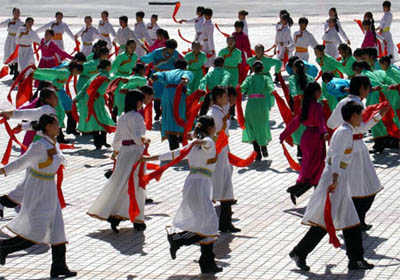| |

To everyone's surprise, the daughter quietly rose, got off the cart, and followed the people, swinging her arms and stamping her feet with them. When people saw her, she was sweating all over, and her disease had been miraculously cured.
The good news spread and from then on, people began to follow suit and treat young women who suffered from similar diseases by dancing around them in the same manner. The dance became known as "Andai." If women were depressed because of problems in love and marriage, their families would invite the local shaman to dance the Andai to keep away disease and misfortune.. No musical instruments accompany the Andai dance, but there are fixed rhythms and librettos. Some dance movements were improvised, and were simple and standard. Led by the shaman the dancers would circle the singer and dance around her. In this way, they tried to console the patient. They sang encouraging sentences. As the rhythm quickened, so did the pace of the dancers. The patient was stimulated and because of this, recovered.
Later the dance was used in some mass rallies, such as ceremonies to pray for rain and the Nadam Fairs (Nadam means game in Mongolian). It became increasingly popular and developed into a kind of group dance, which became a depiction of life and an expression of human emotion.
|
|
